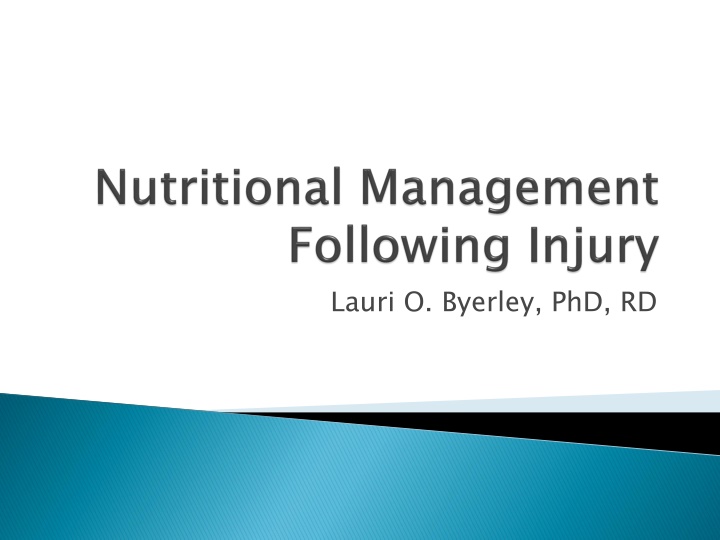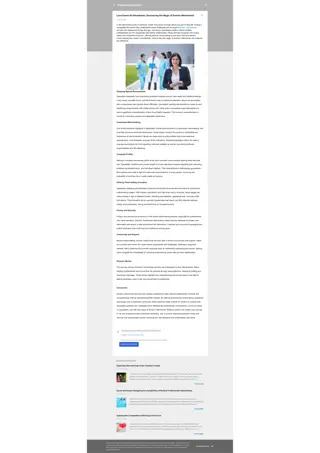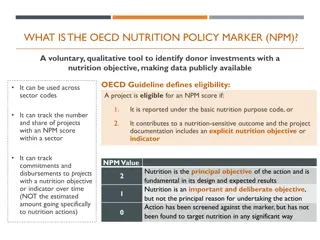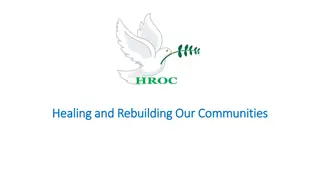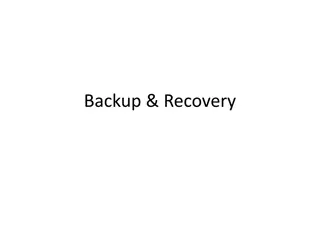Importance of Nutrition in Patient Healing and Recovery
Gain insight into the critical role of nutrition in aiding patients in their recovery from injuries and enhancing their physical well-being post-injury. Explore the phases of injury, the physiological and metabolic impacts of each phase, and the corresponding nutritional support strategies. Delve into a case study of a young male who sustained severe injuries in a motor vehicle accident and required intensive care. Understand the significance of proper nutrition in trauma, surgery, sepsis, and burns. Additionally, learn about metabolic pathways, muscle wasting, and hormonal responses in the body during the recovery process.
Download Presentation

Please find below an Image/Link to download the presentation.
The content on the website is provided AS IS for your information and personal use only. It may not be sold, licensed, or shared on other websites without obtaining consent from the author.If you encounter any issues during the download, it is possible that the publisher has removed the file from their server.
You are allowed to download the files provided on this website for personal or commercial use, subject to the condition that they are used lawfully. All files are the property of their respective owners.
The content on the website is provided AS IS for your information and personal use only. It may not be sold, licensed, or shared on other websites without obtaining consent from the author.
E N D
Presentation Transcript
Gain appreciation for the importance of nutrition in helping your patients heal and physically improve.
Case Study Phases of Injury Physiological and Metabolic Consequence of Each Phase Nutrition Support for Each Phase Summarize
25 YOWM in a MVA 9 months ago Suffered multiple fractures, contusions and closed head injury Stayed 5 weeks in intensive care unit After 1 week responded to physical stimuli but not verbal After 3 weeks opened eyes and started responding to sound but not verbal commands http://www.car-accidents.com/2008- collision-pics/3-23-08-head-injury-1.jpg
Trauma Surgery Sepsis (infection) Burn
Algorithm content developed by John Anderson, PhD, and Sanford C. Garner, PhD, 2000.
Initial shock or ebb phase Brief (<24 hours) Metabolism depressed Flow phase Catabolic Tissue Breakdown Anabolic Lost tissue is reformed
ADH, Antiduretic hormone; NH3, ammonia.
Involves most metabolic pathways Accelerated metabolism of LBM Negative nitrogen balance Muscle wasting
<24 hours Hypovolemia, shock, tissue hypoxia Decreased cardiac output Increased heart rate Vasoconstriction Decreased oxygen consumption Decreased BMR Lowered body temperature Increased acute phase proteins Insulin levels drop because glucagon is elevated.
Hormones involved: Catecholamines Cortisol Aldosterone
3-10 days Increased body temperature Increased BMR Increased O2 consumption Total body protein catabolism begins (negative nitrogen balance) Marked increase in glucose production, FFAs, circulating insulin/glucagon/cortisol Insulin resistance
Hormones involved: Glucagon ( ) Insulin ( ) Cortisol ( ) Catecholamines ( )
10-60 days Protein synthesis begins Positive nitrogen balance
Hormones involved: Growth hormone IGF
From Simmons RL, Steed DL: Basic science review for surgeons, Philadelphia, 1992, WB Saunders.
From Simmons RL, Steed DL: Basic science review for surgeons, Philadelphia, 1992, WB Saunders.
Metabolic response to stress metabolic response to starvation Starvation = decreased energy expenditure use of alternative fuels decreased protein wasting stored glycogen used in 24 hours Late starvation = fatty acids, ketones, and glycerol provide energy for all tissues except brain, nervous system, and RBCs
Stress or Injury (Hypermetabolic state) = Accelerated energy expenditure, Increased glucose production Increased glucose cycling in liver and muscle Hyperglycemia can occur either Insulin resistance or Excess glucose production via gluconeogenesis and Cori cycle ***Muscle breakdown accelerated***
Algorithm content developed by John Anderson, PhD, and Sanford C. Garner, PhD, 2000.
Algorithm content developed by John Anderson, PhD, and Sanford C. Garner, PhD, 2000. Updated by Maion F. Winkler and Ainsley Malone, 2002.
Maintain body mass, particularly lean body mass Prevent starvation and specific nutrient deficiencies Improve wound healing Manage infections Restore visceral and somatic protein losses Avoid or minimize complications associated with enteral and parenteral nutrition Provide the correct amount and mix of nutrients to limit or modulate the stress response and complications Fluid management
Extent of injury will determine nutritional support. Laceration, broken arm case study 25 YOWM in a MVA 9 months ago What do for him during this phase? http://www.car-accidents.com/2008- collision-pics/3-23-08-head-injury-1.jpg
Objectives of optimal metabolic and nutritional support in injury, trauma, burns, sepsis: 1. Detect and correct preexisting malnutrition 2. Prevent progressive protein-calorie malnutrition 3. Optimize patient s metabolic state by managing fluid and electrolytes
Clinical judgment must play a major role in deciding when to begin/offer nutrition support
Energy Protein Vitamins, Minerals, Trace Elements Nonprotein Substrate Carbohydrate Fat
Enough but not too much Excess calories: Hyperglycemia Diuresis complicates fluid/electrolyte balance Hepatic steatosis (fatty liver) Excess CO2 production Exacerbate respiratory insufficiency Prolong weaning from mechanical ventilation
Lean body mass is highly correlated with actual weight in persons of all sizes Studies have shown that determination of energy needs using adjusted body weight becomes increasingly inaccurate as BMI increases
25 YOWM in a MVA 9 months ago 5 11 , 180 lbs at time of accident Transferred to ward 135 lbs Received tube feeding Bed ridden without exercise http://www.car-accidents.com/2008- collision-pics/3-23-08-head-injury-1.jpg
First, fluid resuscitation and treatment When hemodynamically stable, begin nutrition support (usually within 24-48 hours) Nutrition support may not result in +N balance want to slow loss of protein Undernutrition can lead to protein synthesis, weakness, multiple organ dysfunction syndrome (MODS), death
Energy Protein Fat Carbohydrate Vitamins, Minerals, Trace Elements
By mouth http://healthycare- tutorials.blogspot.com/2011/07/healthy- eating.html Enteral Nutrition http://media.rbi.com.au/GU_Media_Libr ary/ServiceLoad/Article/old_man_hospit al_tstock.jpg Parenteral Nutrition http://www.dataphone.se/~hpn/mage.gif
Immunonutrition and immunomodulaton gaining wider use in care of critically ill and injured patients. Thesis specific nutrients can enhance depressed immune system or modulate over reactive immune system ASPEN BOD. JPEN 26;91SA, 1992
Include: supplemental branched chain amino acids, glutamine, arginine, omega-3 fatty acids, RNA, others
Immune-enhancing formulas may reduce infectious complications in critically ill pts but not alter mortality Mortality may actually be increased in some subgroups (septic patients) Use is still controversial Meta-analysis shows reduced ventilator days, reduced infectious morbidity, reduced hospital stay
Along with alanine makes up 70% of amino acids released after injury Major carrier of nitrogen from muscle Non-essential amino acid (body can make) Major fuel for rapidly dividing cells Primary fuel for enterocytes Glutamine alanine glucose Use of glutamine as a fuel spares glucose TPN often enriched with glutamine
Non-essential amino acid (body can make) Requirements increase with stress Appears necessary for normal T-lymphocyte function Stimulates release of hormones growth hormone, prolactin, and insulin Studies show may increase weight gain, increase nitrogen retention, and improve wound health Use controversial some studies show reduced mortality
Part of DNA and RNA Part of coenzymes involved in ATP metabolism Rapidly dividing cells, like epithelial cells and T lymphocytes, may not make Nucleotides are needed during stress. Addition of nucleotides to immune- enhancing diets shown to reduce infections, ventilator days, hospital stay
Vitamin C and E; selenium, zinc, and copper Meta-analysis (11 trials) Use significantly reduced mortality No effect on infectious complications Current recommendation provide combination of all of these http://www.secretsofhealthyeatin g.com/image- files/antioxidants.jpg
Incorporated into cell membranes Influence membrane stability membrane fluidity Cell mobility and Cell signaling pathways http://www.omega-3-forum.com/fattyacids.jpg
Essential amino Acids Oxidation increases with injury/stress May reduce morbidity and mortality Study trauma patients Improved nitrogen retention, transferrin levels, lymphocyte counts Use is still controversial http://extremelongevity.net/wp-content/uploads/Branched_chain_aa.jpg
25 YOWM in a MVA 9 months ago Patient is bedridden. He is able to move all 4 limbs without any coordination. Does not appear to respond to voices. Tube fed weight gain common. Stable enough to go to skilled nursing center Mother refuses skilled nursing center and takes him home. Weight increases. Becomes constipated. http://www.car-accidents.com/2008- collision-pics/3-23-08-head-injury-1.jpg
Goal - replacement of lost tissue What has been happening? Reduced calories Added fiber to tube feeding Pushed water before and after each feeding Gave prune juice twice a day Get bed weight
Dur ation <24 hrs Dur- - ation Nutritional Needs Replace fluids Nutritional Needs Phase Ebb Phase Role Role Physiological BMR temp O2 consumed heart rate Acute phase proteins Physiological Hormones Catechol- amines Cortisol Aldosterone Hormones Maintenance of blood volume Flow Catabolic 3-10 days Maintenance of energy BMR temp O2 consumed Negative N balance glucagon insulin cortisol catecholami nes Insulin resistance Appropriate calories to maintain weight Adequate protein to stabilize or reverse negative N balance Calories, protein and nutrients for anabolism Anabolic 10-60 days Replacement of lost tissue Positive N balance Growth hormone IGF
So why is this important for physical therapist? What did this patient lose? What is this called? Is more dietary protein better? What happened when the patient was fed too much? Any lessons for athletes here?
Aldosteronecorticosteroid that causes renal sodium retention Antidiuretic hormone (ADH) stimulates renal tubular water absorption These conserve water and salt to support circulating blood volume
ACTHacts on adrenal cortex to release cortisol (mobilizes amino acids from skeletal muscles) Catecholamines epinephrine and norepinephrine from renal medulla to stimulate hepatic glycogenolysis, fat mobilization, gluconeogenesis
Interleukin-1, interleukin-6, and tumor necrosis factor (TNF) Released by phagocytes in response to tissue damage, infection, inflammation, and some drugs and chemicals
